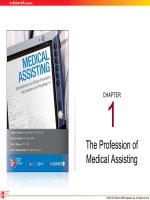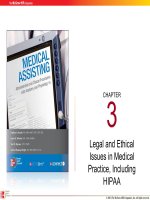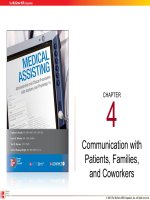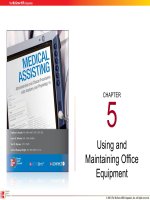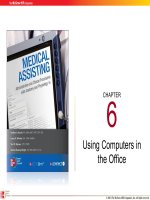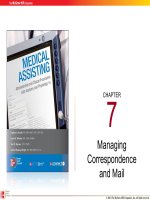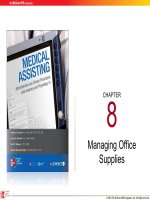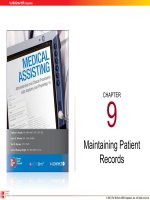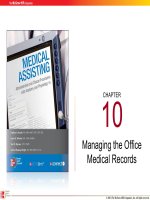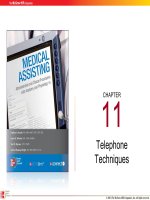Lecture Medical assisting: Administrative and clinical procedures with anatomy and physiology (4e) – Chapter 1
Bạn đang xem bản rút gọn của tài liệu. Xem và tải ngay bản đầy đủ của tài liệu tại đây (1018.47 KB, 48 trang )
CHAPTER
1
The Profession of
Medical Assisting
© 2011 T he McGraw -Hill Com panie s, Inc. A ll rights reserv ed.
1-2
Learning Outcomes
1.1 Describe the job responsibilities of a
medical assistant.
1.2 Discuss the professional training of a
medical assistant.
1.3 Identify the personal characteristics a
medical assistant needs.
1.4 Define multiskilled health professional.
© 2011 T he McGraw -Hill Com panie s, Inc. A ll rights reserv ed.
1-3
Learning Outcomes (cont.)
1.5 Explain the importance of continuing
education for a medical assistant.
1.6 Describe the process and benefits of
certification and registration.
1.7 List the benefits of becoming a member
of a professional association.
© 2011 T he McGraw -Hill Com panie s, Inc. A ll rights reserv ed.
1-4
Introduction
• Fast-growing
occupation
• Generalist
• Medical assistant
– Graduate of accredited
institution
– Multitasking skills
– Someone trained in
all departments of the
facility
A multitasking professional is someone who is able to work in the
administrative area, the clinical areas, and the financial areas.
© 2011 T he McGraw -Hill Com panie s, Inc. A ll rights reserv ed.
1-5
A Successful Student – Key Factors
• Organizational skills – prepare in advance
• Study habits
– Quiet area
– Study “buddy”
• Set goals
© 2011 T he McGraw -Hill Com panie s, Inc. A ll rights reserv ed.
1-6
Growth of the MA Profession
• According to U.S. Department of Labor - Bureau
of Statistics, medical assistants will hold 565,000
jobs by 2016; an increase of 35% from 2006
– 60% in physicians’ offices
– 14 % in hospitals
– Almost 10% in nursing homes and offices of other
health-care practitioners
– Remainder in outpatient care centers, laboratories,
and other health-care-related services
© 2011 T he McGraw -Hill Com panie s, Inc. A ll rights reserv ed.
1-7
Knowledge Base Needed
© 2011 T he McGraw -Hill Com panie s, Inc. A ll rights reserv ed.
1-8
Knowledge Base Needed (cont.)
• Provide exceptional customer service
• Practice management
• Current patient treatments and education
© 2011 T he McGraw -Hill Com panie s, Inc. A ll rights reserv ed.
1-9
Apply Your Knowledge
What are the key factors to your success as a
student?
ANSWER: Developing good organizational skills and
good study habits, and setting goals.
Good
Job
© 2011 T he McGraw -Hill Com panie s, Inc. A ll rights reserv ed.
1-10
American Association of Medical
Assistants (AAMA)
• Established: 1956
• Purpose of the organization is to raise the
standard of medical assisting to a more
professional level
• The Code of Ethics of AAMA
– Sets forth principles of ethical and moral conduct as
they relate to the medical profession and the
particular practice of Medical Assisting
© 2011 T he McGraw -Hill Com panie s, Inc. A ll rights reserv ed.
1-11
Importance of Medical Assistant
Credentialing
• Malpractice
– Having credentialed personnel or staff will
lessen the likelihood of legal challenges of the
quality of care
• Managed Care Organizations (MCO)
– Place great importance on professional
credentials for employees
• Meet components of state and federal
regulations
© 2011 T he McGraw -Hill Com panie s, Inc. A ll rights reserv ed.
1-12
Certified Medical Assistant (CMA)
• CMA(AAMA)
credential is awarded
by the Certifying
Board of the AAMA
• Certification
examination
evaluates mastery of
medical assisting
competencies
• Recertify every
5 years
– 60 contact hours
• 10 each in clinical,
administration, general
areas
• 30 additional hours in
any area
© 2011 T he McGraw -Hill Com panie s, Inc. A ll rights reserv ed.
1-13
American Medical Technologists (AMT)
Organization
• Credentials medical assistants
as Registered Medical
Assistants (RMA)
• Education and experience requirements
– High school diploma or equivalent
– Graduation from an accredited program
– Pass the AMT examination
© 2011 T he McGraw -Hill Com panie s, Inc. A ll rights reserv ed.
1-14
American Medical Technologists (AMT)
Organization (cont.)
© 2011 T he McGraw -Hill Com panie s, Inc. A ll rights reserv ed.
1-15
RMA(AMT)/CMA(AAMA) Examinations
• General medical knowledge
• Administrative
knowledge
• Clinical knowledge
© 2011 T he McGraw -Hill Com panie s, Inc. A ll rights reserv ed.
1-16
Medical Assistant Associations
• Set standards for quality and performance
• Define tasks and functions for an
occupation
• Provide opportunities for networking
• Further the profession
• Assist members to achieve career goals
© 2011 T he McGraw -Hill Com panie s, Inc. A ll rights reserv ed.
1-17
CMA(AAMA) Member Benefits
•
•
•
•
•
•
•
Professional publications
Educational opportunities
Group insurance
Legal information
Networking
Legislative monitoring
Website:
© 2011 T he McGraw -Hill Com panie s, Inc. A ll rights reserv ed.
1-18
RMA(AMT) Member Benefits
•
•
•
•
•
Professional publications
AMT Institute for Education
Group insurance programs
Legislature legal representation
Annual meetings and educational
seminars
• Student membership
• Website:
© 2011 T he McGraw -Hill Com panie s, Inc. A ll rights reserv ed.
1-19
Apply Your Knowledge
• What are two reasons why credentialing
is important?
ANSWER: The likelihood of a legal challenge to quality of
care decreases when employees are certified, and Managed
Care Organizations place importance on credentials for
employees.
BRAVO!
© 2011 T he McGraw -Hill Com panie s, Inc. A ll rights reserv ed.
1-20
Apply Your Knowledge
Correct
• List three things professional
medical assistant associations do or
provide.
ANSWER: Medical Assistant Associations
• Set standards for quality and performance for the
profession
• Define tasks and functions for an occupation
• Provide opportunities for member networking
• Assist members to achieve career goals
© 2011 T he McGraw -Hill Com panie s, Inc. A ll rights reserv ed.
1-21
Formal Training and Educational
Programs
• Vocational-technical high schools
• Postsecondary vocational schools
• Community and junior colleges
• Four-year colleges and universities
© 2011 T he McGraw -Hill Com panie s, Inc. A ll rights reserv ed.
1-22
Accreditation
• The process by which programs are
officially authorized
• Two recognized entities for accrediting MA
programs
– The Commission for Accreditation of Allied
Health Education Programs (CAAHEP )
– Accrediting Bureau of Health Education
Schools (ABHES)
• Must meet minimum standards
© 2011 T he McGraw -Hill Com panie s, Inc. A ll rights reserv ed.
1-23
Graduating from an Accredited Program
• Greater career
options
– Completion of a
program that
meets national
standards
– Provides recognition of
your education
by professional peers
– Makes you eligible for
registration
© 2011 T he McGraw -Hill Com panie s, Inc. A ll rights reserv ed.
1-24
Externships
• Obtain practical work experience
• Required by accredited
programs
• Duties will be planned
to meet your program’s
requirements
© 2011 T he McGraw -Hill Com panie s, Inc. A ll rights reserv ed.
1-25
National Healthcare Association (NHA)
• Established in 1989 as an information
resource and network
• Offers certification exams and continuing
education
• Services:
– Continuing education
– Program development
– Education, career advancement, and networking
– Registry of certified professionals
© 2011 T he McGraw -Hill Com panie s, Inc. A ll rights reserv ed.
